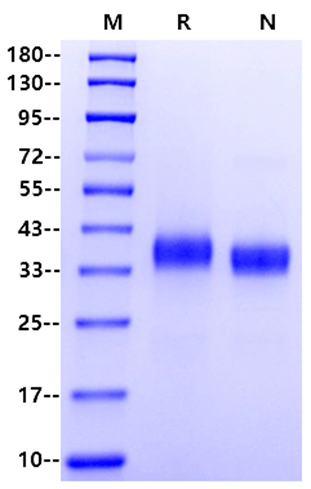产品介绍 评论(0)
物种
SARS-CoV-2Accession
P0DTC2表达序列
Arg319-Phe541, with N-terminal 8*His HHHHHHHHGGGGSDYKDDDDKRVQPTESIVRFPNITNLCPFDEVFNATRFASVYAWNRKRISNCVADYSVLYNLAPFFTFKCYGVSPTKLNDLCFTNVYADSFVIRGDEVRQIAPGQTGNIADYNYKLPDDFTGCVIAWNSNKLDSKVSGNYNYLYRLFRKSNLKPFERDISTEIYQAGNKPCNGVAGFNCYFPLRSYSFRPTYGVGHQPYRVVVLSFELLHAPATVCGPKKSTNLVKNKCVNF表达宿主
HEK293分子量
35-43kDa (Reducing)纯度
>95% by SDS-PAGE
内毒素含量
<0.1EU/μg标记
Unconjugated标签
His Tag性状
Lyophilized Powder缓冲体系
PBS, pH7.4溶解方法
Reconstitute at 0.1-1 mg/ml according to the size in ultrapure water after rapid centrifugation.储存条件
· 12 months from date of receipt, -20 to -70 °C as supplied.
· 6 months, -20 to -70 °C under sterile conditions after reconstitution.
· 1 week, 2 to 8 °C under sterile conditions after reconstitution.
· Please avoid repeated freeze-thaw cycles.
Coronaviruses (CoVs) are enveloped viruses with a positive sense RNA genome, that belong to the subfamily Coronavirinae within the family Coronaviridae, which is part of the Nidovirales order. The CoVs virion contains at least four structural proteins: spike (S), envelope (E), membrane (M) and nucleocapsid (N). Among them, the S protein plays an essential role in viral attachment, fusion, entry, and transmission. It comprises an N-terminal S1 subunit responsible for virus–receptor binding and a C-terminal S2 subunit responsible for virus–cell membrane fusion. S1 is further divided into an N-terminal domain (NTD) and a receptor-binding domain (RBD). During infection, CoV first binds the host cell through interaction between its S1-RBD and the cell membrane receptor, triggering conformational changes in the S2 subunit that result in virus fusion and entry into the target cell.
电泳
 2μg (R: reducing conditions, N: non-reducing conditions).
2μg (R: reducing conditions, N: non-reducing conditions).



评论(0)